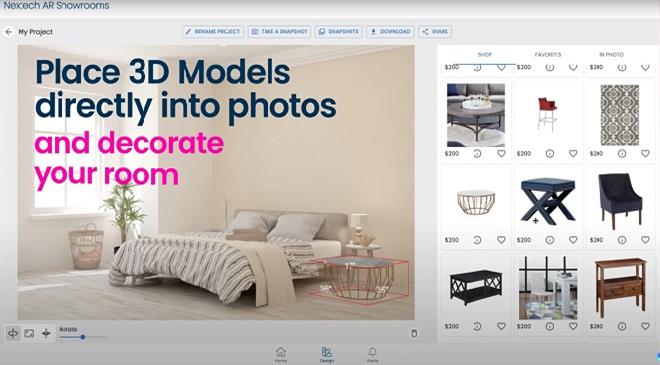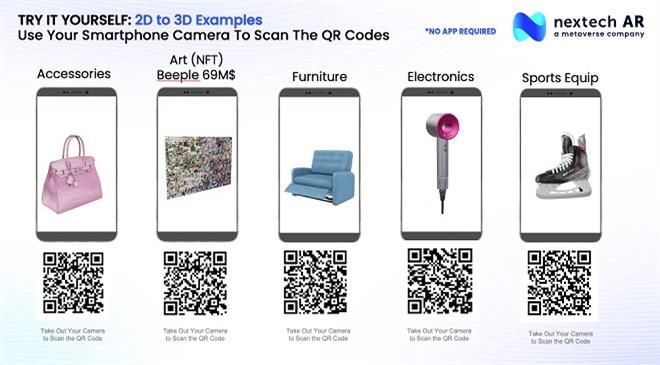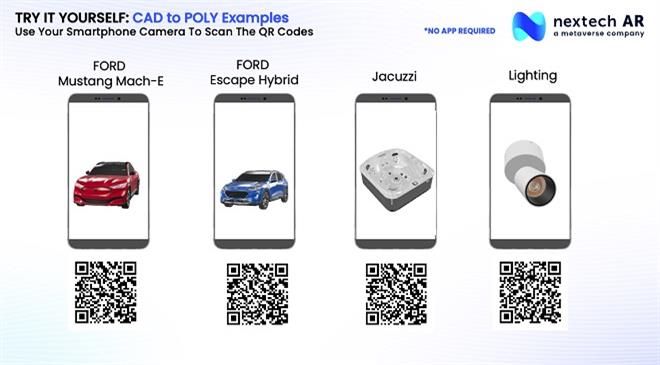AR is crucial to the creation of metaverse
A metaverse company, Nextech AR Solutions, develops and operates platforms critical to creating and populating the metaverse, including spatial mapping technology and augmented reality (AR) solutions. These include three-dimensional (3D) product visualisations, human holograms, 360° portals and augmented labs that alter e-commerce, digital advertising, learning in higher education, hybrid virtual events and training. In a chat with Fibre2Fashion, Nextech AR CEO and Founder Evan Gappelberg discusses all about metaverse, AR, 3D, etc.
What all technologies are needed in creating a metaverse?
The metaverse is the new evolution of the internet (Web 3.0) that is enhanced to deliver 3D content, spatially organised information and experiences. To create the metaverse, you need to create a 3D environment through spatial mapping technology, and 3D content using AR or virtual reality (VR) technologies.
What is AR? How is it related to the metaverse?
AR (augmented reality) uses the real world and enhances it with digital content, layering new strata of perception, and supplementing your reality or environment. Examples include Pokemon GO, Human Holograms, AR wayfinding/navigation, 3D/AR models, and more. AR adds digital elements to a live view, most notably through the camera on a smartphone. When AR glasses are released, you will be able to experience augmented reality through your glasses instead of through your phone.
AR is crucial to the creation of the metaverse, and the way users experience it. Brands, companies, and individuals will create AR content that will be showcased in the metaverse.
Is there different AR for web and mobile, like WebAR and MoblieAR? Technically, what is the difference between the two?
Web AR involves overlaying virtual 3D assets over physical reality using a standard web browser (doesn’t require native apps). This format is ideal for enabling e-commerce sites to offer enhanced product visualisation to their clients thereby increasing engagement, add-to-carts, and reducing returns.
MobileAR is augmented reality that a user can take with them and experience wherever they go, unlike WebAR. This means that the hardware required to implement an AR application is something that you take anywhere, for example, a mobile smartphone. Through the screen of a mobile smartphone, you can view 3D AR assets and experiences that are overlaid into the real, physical world.
For a layman, .com is e-commerce. Is there any such identification for metaverse?
Yes, the metaverse can be simply defined as Web 3.0.
- Web 1.0 --> The internet connected us to information
- Web 2.0 --> Social media connected us to people
- Web 3.0 --> The metaverse will connect us to people, places, and things!
Is there any prerequisite to enjoy the metaverse? For example, 3D glasses?
All that’s needed to experience the metaverse at this current time is a smartphone or tablet. Through the screens of these devices, you can experience AR content that’s overlayed onto our physical world, like 3D models, human holograms, AR navigation, and more!
In the future, we will experience the metaverse through AR glasses or VR headsets. When the AR glasses are released, it will change the experience of the metaverse to be completely seamless and immersive. Your glasses will contain a tiny computer that will overlay 3D/AR content into your physical environment, instead of having to view it through your phone screen. This will be a much better experience for users, and this is when the metaverse will really take off and obtain mass adoption.
Is there also something called AR Environment? What is it?
An AR Environment can also be referred to as an “AR Map” or a spatial map, which is critical to building the metaverse.
Any time Nextech’s ARitize Maps technology is used to create a new AR Map, the app creates point cloud maps of any given area that is then used for localisation (determining the exact physical location of the device) and placement of AR content to be displayed and anchored to physical location. The combination of an AR map with localised AR content, creates a metaverse experience!

What is the use of Artificial Intelligence (AI) in metaverse?
Artificial intelligence plays a large role in the metaverse.
3D MODELS: For example, Nextech’s ARitize 3D’s patent-pending technology leverages AI to enhance the building of quality 3D models from simple 2D photos at scale for e-commerce websites.
We are a disruptive end-to-end solution for the AR industry. Through a simple JavaScript tag integration, product photos are automatically onboarded, and 3D models are created for each product and then hosted on ARitize 3D’s cloud. Using proprietary AI and computer vision innovations, the production of 3D models can be scaled to thousands per week. These 3D/AR models will be used as content to populate the metaverse.
AR MAPS / SPATIAL MAPPING: ARitize Maps builds upon an AI enabled solution for smartphone camera devices to recognise their surroundings and display hyper-accurate location-anchored AR content.
Can one experience the metaverse through an app on Android or iOS phone?
Yes! Nextech AR Solutions has just launched its beta metaverse app, ARitize Maps. This app is an all-in-one metaverse creation studio, and the first end-to-end metaverse mapping solution for consumers and brands alike. With the launch of ARitize Maps, Nextech is offering a frictionless and seamless solution for everyone to enter the metaverse.
The ARitize Maps app will be available for both iOS and Android. Through this free app, everyone can spatially map their location within minutes, and populate it with interactive 3D objects, navigation, wayfinding, audio, text, images and more. Nextech will provide a number of created and pre-loaded 3D objects, and creators can upload their own OBJ (standard 3D image format) files and create their own 3D objects to populate their metaverse. The navigation feature allows users to map out a 50 sq metre area and include wayfinding features, in order to direct visitors in their metaverse to a desired location or object. Users can publish and share their metaverse for others to experience while in the location. Currently, the app is available as a free download with no in-app purchases and provides an unlimited number of maps for the first month; however when the app is released, it will contain in-app purchases and monthly subscription plans.

How big is the metaverse industry at present? At what rate is it expected to grow over the next few years?
According to Bloomberg Intelligence, the burgeoning metaverse industry will provide an $800 billion market opportunity by 2024.
What is Mixed Reality (MR)?
Mixed reality (MR) is the merging of real and virtual worlds to produce new environments and visualisations, where physical and digital objects co-exist and interact in real time.
What should companies investing in metaverse focus on? Is it Return on Investment (RoI) or Return on Experience (RoE)? How do you define the latter?
They should focus on both RoI and RoE.
AR and the metaverse empower your customers to visualise products in their space before buying. They can pinch, zoom, rotate and see all of the details of a product. Data shows that AR can increase conversions up to 94 per cent while reducing returns by 40 per cent. This is a massive RoI, as it can assist to reduce costs and increase revenue.
RoE measures the experience of customers in using a service or buying a product. 3D/AR products bridge the gap between in-person and online shopping, providing an exciting, immersive shopping experience that keeps customers more engaged, better informed and helps brands to stand out from the competition. Data shows that 61% of consumers prefer retailers with AR experiences!
Is there something called mini-metaverse too? How is it implemented in industrial manufacturing environments?
Nextech has coined the term “mini-metaverse”.
Through Nextech’s ARitize Maps mobile application, anyone can create their own “mini-metaverse” by spatially mapping their location and populating it with 3D/AR content. The mini-metaverse can be up to 50 sq metres. A good example is an AirBnB host creating a mini-metaverse for their rental property.
Through Nextech’s ARitize Studio, larger “mini-metaverses” can be created. Think museums, airports, sports stadiums and more! They can feature AR wayfinding, human holograms and unique, 3D/AR experiences and visualisations for visitors and guests.
What does NextTech AR Solutions do? Does it create metaverse or only provide solutions with which metaverse can be created?
Nextech AR Solutions provides both. Nextech is the engine accelerating the growth of the metaverse. Using breakthrough AI, Nextech AR is able to quickly, easily and affordably ARitize (transform) vast quantities and varieties of existing assets at scale making products, people and places ready for interactive 3D use, giving creators at every level all the essential tools they need to build out their digital AR vision in the metaverse. Our platform’s agnostic tools allow brands, educators, students, manufacturers, creators, and technologists to create immersive, interactive and the most photo-realistic 3D assets and digital environments, compose AR experiences, and publish them omnichannel. With a full suite of end-to-end AR solutions in 3D commerce, education, events, and industrial manufacturing, Nextech AR is in a unique position to meet the needs of the world’s biggest brands and all metaverse contributors.
What solutions do you offer to fashion e-commerce companies?
Nextech’s strategy is not to invest in creating technology for fitting and try-ons, instead focus on creating 3D assets that will power such try-on applications. Try-on technologies do become commodity as hardware and software releases improve. For example, virtual glasses try-on, which used to be difficult to do accurately in WebAR just a year ago, now is supported natively in iOS. We have created 3D models of glasses for our clients. When the tech becomes reliable for virtual clothing, we will ramp up our tech to creating soft-material 3D models like clothes.

Is AR and metaverse together going to change e-commerce as we know it today? What is it going to look like in the future?
Absolutely! In 2022, Nextech is experiencing a massive wave of new interest and demand for everything 3D and metaverse related from all over the globe and this demand will only continue to grow. Brands and companies who do not invest in 3D models, AR and the metaverse will be left behind their competitors, especially in e-commerce. Providing new, immersive, engaging shopping experiences is essential to increasing brand loyalty, increasing sales and reducing returns. Once you go 3D, you don’t go back to 2D because the benefits are significant.
I believe that we are at the beginning of a new era in humanity where AI, machine learning (ML) and 3D technology will become the dominant technologies for the foreseeable future.
What technology is used for creating a 3D virtual retail apparel showroom? Does Nextech AR offer all of them?
Nextech owns and operates technology to create 3D virtual showrooms that can be used for furniture, jewellery, apparel, and more.
With 3D/AR visualisation, customers can see and experience products from every angle before they buy. And with the ability to zoom into your product, they can examine the smallest of details and product features.




